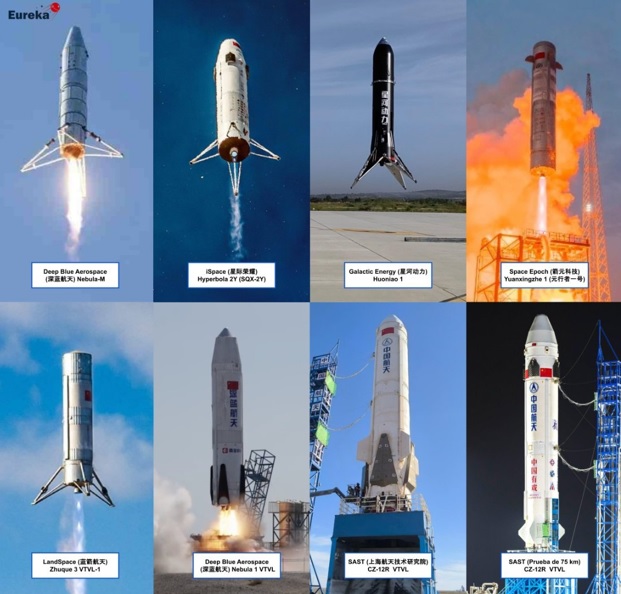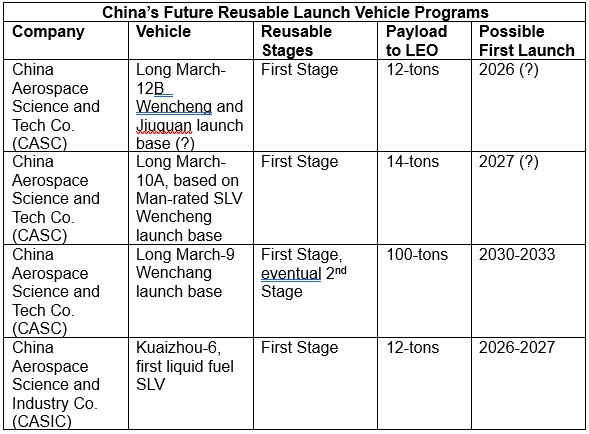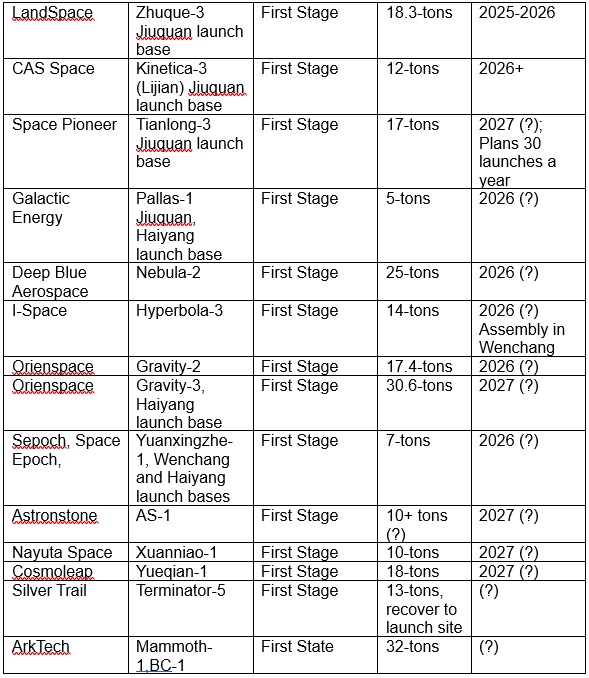Geostrategy-Direct, October 15, 2025
By Richard Fisher
During the Cold War there was the perceived “bomber gap” between the United States and the former Soviet Union, followed by a “missile gap.”
Decades down the road in the current United States-China Cold War, the U.S. should be planning a response to a looming potential strategic Reusable Launch Vehicle (RLV) gap with China.

This is important because reusable space launch vehicles (SLVs) could quickly become significant multi-role military platform, undertaking conventional or non-nuclear bombing missions, nuclear bombing missions, in addition to transporting military payloads to multiple Earth orbits and taking people and critical cargo necessary for sustaining strategic positions on the Moon.
For example, one SpaceX Falcon-9 RLV might carry up to 8x precision-guided 2000-kilogram (4,400 lbs) non-nuclear and maneuverable hypersonic glide vehicle (HGV) bombs that could devastate a military base or a key economic infrastructure target — and currently could launch a repeat mission in nine days.
But such a RVL bombing rate can only get better; Consider the non-nuclear bombing potential of 100 Falcon-9s that are able to launch two missions a day.
But to be clear, in 2025 the “RLV-Gap” favors the United States: By Oct. 13, out of 121 total U.S. space launches so far, 117 were from the SpaceX Corporation and the vast majority utilized their reusable Falcon-9 (17.5 metric tons to Low Earth Orbit (LEO)) or reusable Falcon Heavy SLVs (37 tons to LEO).
Just one U.S. space company with RLVs — SpaceX — accounts for 96 percent of U.S. space launches so far in 2025, creating a significant strategic advantage: the U.S. does not have to manufacture every SLV it uses.
Having just completed a successful test flight on Oct. 13, when operational, the reusable SpaceX Starship could have an initial payload capability of 100 tons to LEO that could grow to 150 tons.
Other U.S. or allied-nation companies that are developing RLVs include: Blue Origin New Glenn, 45 tons to Low Earth Orbit (LEO); United Launch Alliance Vulcan Centaur, 27 tons to LEO; Rocket Labs Neutron, 13 tons to LEO; and a planned European reusable “Ariane Next” could have an eventual LEO payload of 100 tons.
China, as of Oct. 13, has only conducted 61 space launches and none of them by reusable SLVs.
But this could change rapidly in several years.
At a Sept. 22 forum on “The China Threat” attended by this analyst during the 2025 U.S. Air and Space Force Association convention in National Harbor, the U.S. Space Force Deputy Chief of Space Operations for Intelligence, Brig. Gen. Brian Sidari, stated:
“It’s concerning how fast they’re going…I’m concerned about when the Chinese figure out how to do reusable lift that allows them to put more capability on orbit at a quicker cadence than currently exists.”
The fact is that China has been investing massively in RLVs, the companies that will make them and the new launch facilities that will enable these RLVs to conduct “civil” and military missions — as all space activities in China are controlled by the People’s Liberation Army (PLA).


It can be assured the PLA will require military value from their fleet of RLVs.
The chart below shows that as of late 2025 there are at least 15 Chinese companies developing at least 18 new reusable launch vehicles.
It should be expected that more Chinese RLV companies will emerge in the coming years, and that China will legally or illegally proliferate RLVs to its legitimate and rogue partners like North Korea.
China is now building at least four new launch pads at the Hainan Commercial Space Launch Base, near the strategic Wencheng Satellite Launch Base that currently support Chinese Space Station and all Moon missions.
But commercial (private company) launch bases are also being built at the Jiuquan Satellite Launch Base, that can also support manned space launch missions.
In addition, a new “offshore” space launch base is being built from reclaimed land off the shore of Shandong Province, called the Haiyang Commercial Space Launch Base, that by 2030 could be supporting about 100 annual space launches.
As far as can be determined, SpaceX has not revealed the number of Falcon-9 RLVs that it has produced to support its launch rate.
But if the 18 Chinese RLV programs were to produce 20 RLVs each, that could approach 360 RLVs and it is very likely that the PLA would require that each have military-mission capable second stages, to launch satellites or to deliver kinetic payloads — perhaps in volleys of 1,000 or more warheads.
As such, there is a looming requirement for the United States to plan deterrence and retaliation capabilities, to ensure that the U.S. Space Force, U.S. Air Force, U.S. Navy and the U.S. Army have access to RLVs to conduct space launch and kinetic missions.
This may require that the Department of War plan for a “national reserve” of RLVs that can be achieved by deeply sheltered/protected stockpiles of RLVs, or by supporting commercial RLV fleets that can also serve as an emergency “reserve” force of RLVs.
In addition, there may be a requirement to design new RLVs with mobility, or the ability to move from storage to a distributed launch platform, as there will also be a requirement for many more launch facilities to complicate attack from China.

You must be logged in to post a comment Login